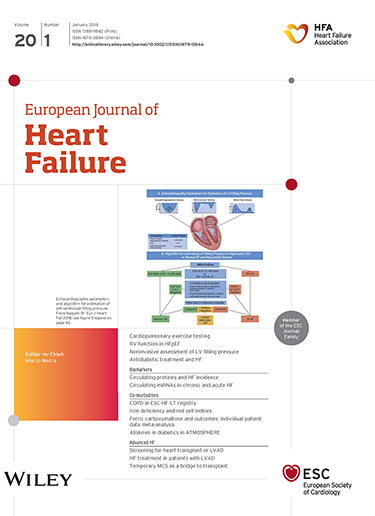Recurrent event analyses in patients receiving maintenance dialysis and the effect of higher- versus lower-dose chronic intravenous iron therapy: A report focusing on heart failure events from the PIVOTAL trial.
IF 16.9
1区 医学
Q1 CARDIAC & CARDIOVASCULAR SYSTEMS
引用次数: 0
Abstract
AIMS In the PIVOTAL trial, a proactive high-dose regimen of intravenous iron sucrose, compared to a lower-dose reactive regimen, reduced the risk of first and recurrent events of the primary endpoint in haemodialysis patients. We present the various approaches of recurrent event analyses for the primary endpoint and for the composite of cardiovascular (CV) death or heart failure hospitalization and their non-fatal components. METHODS AND RESULTS Patients were randomized to a proactive maintenance dose of iron sucrose (average 264 mg/month) or a reactive treatment regimen (average 145 mg/month). We compared the results of time-to-first event analyses with recurrent event analysis using the negative binomial model and methods proposed by Wei-Lin-Weissfeld, Andersen and Gill, Lin, Wei, Yang and Ying [LWYY], Mao and Lin, and Rondeau and colleagues. The 2141 haemodialysis patients were followed for a median of 2.1 years and experienced 936 primary recurrent events, which is 42% higher than the number of 658 first events. Proactive regimen patients had 429 primary events (19.4/100 patient-years) compared with 507 events in the reactive regimen patients (24.6/100 patient-years) (rate ratio 0.77, 95% confidence interval [CI] 0.66-0.92, p = 0.0027, LWYY). Recurrent events were also reduced in the proactive regimen for the composite of CV mortality and heart failure hospitalizations (rate ratio 0.73, 95% CI 0.56-0.93, p = 0.013). Recurrent event analyses based on other approaches were very similar to those given above based on the method of LWYY. CONCLUSION A higher dose of chronic intravenous iron therapy compared to a lower dose substantially reduced the total burden of important recurrent events of death and CV disease in patients with end-stage kidney disease receiving maintenance haemodialysis therapy.接受维持性透析的患者的复发事件分析和高剂量与低剂量慢性静脉铁治疗的影响:一份关于枢纽试验中心力衰竭事件的报告。
在PIVOTAL试验中,与低剂量反应性方案相比,主动高剂量静脉注射蔗糖铁方案降低了血液透析患者主要终点首次和复发事件的风险。我们提出了用于主要终点和心血管(CV)死亡或心力衰竭住院及其非致命成分的复合复发事件分析的各种方法。方法和结果将患者随机分配到主动维持剂量的蔗糖铁(平均264 mg/月)或反应性治疗方案(平均145 mg/月)。我们使用weilin - weissfeld、Andersen和Gill、Lin、Wei、Yang和Ying [LWYY]、Mao和Lin以及Rondeau等人提出的负二项模型和方法,将首次事件时间分析结果与反复事件分析结果进行了比较。2141例血液透析患者被随访了中位2.1年,经历了936次原发性复发事件,比658次首次复发事件的数量高出42%。主动方案患者发生429起原发事件(19.4/100患者-年),而被动方案患者发生507起原发事件(24.6/100患者-年)(率比0.77,95%可信区间[CI] 0.66-0.92, p = 0.0027, LWYY)。在心血管疾病死亡率和心力衰竭住院的综合情况下,主动方案的复发事件也减少了(发生率比0.73,95% CI 0.56-0.93, p = 0.013)。基于其他方法的重复事件分析与上述基于LWYY方法的重复事件分析非常相似。结论:在接受维持性血液透析治疗的终末期肾病患者中,与低剂量相比,高剂量的慢性静脉铁治疗显著降低了重要的死亡和心血管疾病复发事件的总负担。
本文章由计算机程序翻译,如有差异,请以英文原文为准。
求助全文
约1分钟内获得全文
求助全文
来源期刊

European Journal of Heart Failure
医学-心血管系统
CiteScore
27.30
自引率
11.50%
发文量
365
审稿时长
1 months
期刊介绍:
European Journal of Heart Failure is an international journal dedicated to advancing knowledge in the field of heart failure management. The journal publishes reviews and editorials aimed at improving understanding, prevention, investigation, and treatment of heart failure. It covers various disciplines such as molecular and cellular biology, pathology, physiology, electrophysiology, pharmacology, clinical sciences, social sciences, and population sciences. The journal welcomes submissions of manuscripts on basic, clinical, and population sciences, as well as original contributions on nursing, care of the elderly, primary care, health economics, and other related specialist fields. It is published monthly and has a readership that includes cardiologists, emergency room physicians, intensivists, internists, general physicians, cardiac nurses, diabetologists, epidemiologists, basic scientists focusing on cardiovascular research, and those working in rehabilitation. The journal is abstracted and indexed in various databases such as Academic Search, Embase, MEDLINE/PubMed, and Science Citation Index.
 求助内容:
求助内容: 应助结果提醒方式:
应助结果提醒方式:


